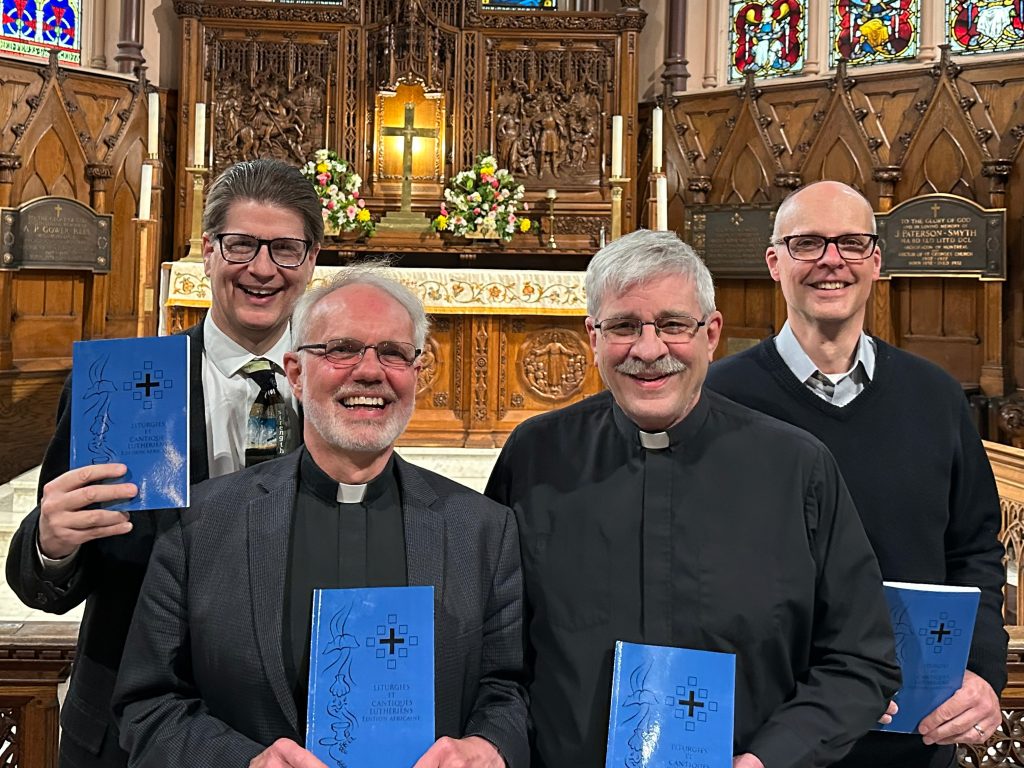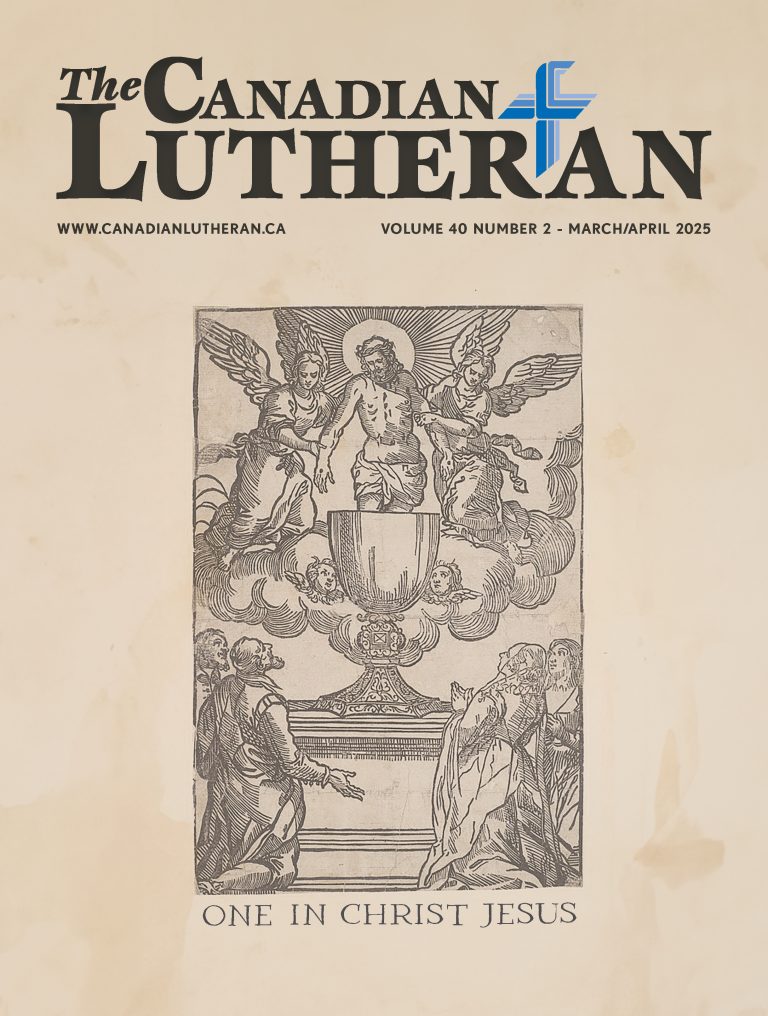“We Need Hymns” Singing About Jesus in Francophone Africa

by Phillip Magness
Hymns and Hymnals
Lutheranism has been associated with congregational song since the earliest days of the Reformation. Even before the Augsburg Confession, Martin Luther recognized the pedagogical usefulness of music and the need for the saints to sing the faith.1 Lutherans developed a rich and robust treasury of hymnody, leading to their becoming popularly known as “the singing church.”2 While the technology of recent decades has increased the use of printed bulletins and screens, most Lutherans today still sing hymns and liturgy out of hymnals. While the use of hymnals is not a true mark of the church, one can fairly argue that singing from hymnals is part of the idioms of Lutheranism.
The content of hymnals can be divided into two neat categories: songs the people are singing and wish to continue singing, and songs those who compile hymnals want them to sing. Early hymnals were necessarily composed entirely of the latter category, as they were promulgated for the introduction of new or revised songs the Reformers desired for their congregations. Contrary to popular notions of Luther opening the floodgates of song, this was a centuries-long project, as congregations needed to be taught both to sing and what to sing.3 In the years since the eighteenth century, however, after those initial two centuries of intentional provision of congregational song by the various Christian churches, familiarity and “tunefulness” began to also be criteria.4 Once a set of core hymns was established, the conditions were set for the people to have certain expectations regarding new hymnals. Yet, with the evolution of language, music, and theology, and with the natural creativity of hymnwriters and musicians, new hymnals have continued to emerge, each providing a mix of songs expected by the people and songs hymnal editors hope the people will embrace.
A Lutheran Mission Hymnal for Francophone Africa
The development of the Lutheran Franco-African mission hymnal, Édition africaine (ÉA),5 posed a unique challenge in this regard. In some ways, Africa—being populated with newer church bodies—is like the congregations of the Reformation, lacking a substantive tradition of biblical song. At the same time, many leaders of the Lutheran African churches have had exposure to the broad hymnody of the church at their seminaries and via the internet. In addition, the Lutheran seminary in Dapaong, Togo (Centre Luthérien pour les Études Théologiques [CLET]), has hosted LCMS cantors at various times for church music seminars, and was blessed for years to have a resident teaching missionary with strong skills in music there as a pastor and professor.6 Using the francophone hymnal published in 2009, Liturgies et cantiques luthériens (LCL), a good number of core Lutheran hymns had taken root in Togo, Burkina Faso, Côte d’Ivoire, Republic of Congo (ROC), and the Democratic Republic of Congo (DRC). As a participant in this work, the author made trips to the ROC in addition to teaching at CLET. So, while the need to establish a repertoire of strong hymns was certainly a prime consideration, the editors of ÉA enjoyed a stronger starting position than Luther and Johann Walther had when they produced the first Lutheran hymnal.7

Despite the advantages of modern communications and some hymnic and liturgical knowledge among key leaders, the essential need to nurture a core set of hymns remains. Just as Luther and the Reformers wanted to use the art of music so that the gospel would dwell in people more richly, so has the author heard the plea of many a Lutheran African pastor: “We need hymns.” Yes, the Africans have their own music and sing it well and with great zeal. But their folk song is not rooted in Christianity, and its repetitive nature limits its text capacity.8 While a popular folk chorus can be baptized with Christian lyrics—a fair practice as long as the tune does not carry profane or idolatrous associations—these local songs generally lack capacity to carry rich theological texts or recount much more than highlights from the Scripture’s story of salvation. Also, just as Westerners enjoy the connection to the global church they experience when singing songs from other parts of the world, so do Africans embrace the catholicity of the church in song and wish to inherit with us the rich legacy of music and poetry we so often take for granted. In addition, while some folk music could be adapted for Christian use, the local cultures lack music for the canticles of the historic liturgy, so settings of the Divine Service and Matins are much in demand.
This intersection between “what people know” and “what leaders desire for them” is the critical creative juncture. Err on one side, and one only codifies a set of popular songs that will not much endure; err on the other, and one publishes books that gather dust as they go unused. “Splitting the baby” fails also as a solution: one winds up with a book that lacks cohesiveness and, as a result, invites use of one half over the other. Thus, creative synthesis is required to produce a hymnal that is desirable from the perspectives of both the worshipers and the pastors who care for them. Teaching is still required to bring the people to the hymnal, but that begins with having a hymnal that can be brought to the people.
Personnel, Vision, and Content
And so, driven by the awareness that good hymns and liturgical music are needed to fulfill the Pauline mandates to sing “psalms and hymns and spiritual songs” (Col 3:16; Eph 5:19), a small team worked together to create ÉA as a mission hymnal for francophone Africa. That team was comprised of the author, the Canadian team of David Somers and David Saar, who had produced LCL, and leaders of the Evangelical Lutheran Church of Congo (Église Évangélique Luthérienne du Congo). Their work was guided by two underlying principles: the expressed desire of our African partners to enjoy the beauty of the texts and tunes of our hymnody, and the understanding that adaptations were needed to fit the realities of ministry in Africa.
The vision for this hymnal was drawn from the realization that African mission worship in the twenty-first century is not substantially different from Lutheran mission worship in the late nineteenth century. Just as missionaries expect and accept that the Africans sing a number of their own songs in the service, so did Lutheran missionaries among English speakers anticipate a good amount of popular English hymnody would be sung in their day. Thus, the first English-language hymnal published by Concordia Publishing House (CPH) had only thirty-three hymns.9 These hymns were selected from the core hymns of Lutheranism, the Kernlieder, which sing clearly of Christ as they confess the chief article. They richly teach Christian doctrine, encompass the life of Christ, and extol the Means of Grace. Our LCMS fathers knew that, with a sturdy set of songs like this, gracious accommodation for popular songs of praise could readily be made as they catechized new communities into the faith. Similarly, LCMS missions in francophone Africa have done the same thing. A typical Divine Service in Togo or Congo features local, vernacular songs for the gathering, offering, and sending, while using core hymns from LCL before the sermon and during communion. Over the years, some congregations have taken to singing hymns from LCL (and now ÉA) at other times as well.

ILLF constituting members and LCC President with new French hymnal. (Left to Right) Cantor Phillip Magness, Rev. Dr. David Somers; LCC President Timothy Teuscher, and Rev. Dr. David Saar
Given the amount of familiarity with LCL among several of the synod’s mission partners, the committee developing ÉA decided on a larger number of hymns than the thirty-three core hymns first promoted in English by CPH, and even the forty or fifty hymns that had been taught in various places by the author and other missionaries over the previous decade. However, the principle was the same: sing fewer hymns so that the same hymns are sung more often. Repetitio est mater studiorum. This conveniently aligned with the desire to have a smaller book for the sake of production and shipping costs. LCL was published in Canada, and each book is about the size and weight of a copy of LSB. So, it is expensive and difficult to get many LCLs into the hands of Africans. For this reason, the committee wanted to produce a smaller book and have it published in or near Africa. This would make the book affordable and practical—essential elements for the acceptance of such a hymnal. In the end, ÉA included seventy tunes for 113 hymns covering the Church Year, the Sacraments, justification, sanctification, marriage, vocation, and death, thus providing a solid foundation for Lutheran worship in any franco-African context.
Finally, ÉA also had a liturgical goal. Whereas LCL contains three settings of the Divine Service along with Matins, a noon Office, Vespers, and Compline, the smaller ÉA would not allow for such variety. In addition, many of the African leaders expressed a desire for all eleven members of the “francophone union” (a network of confessional Lutheran francophone African churches) to use the same liturgy. For this reason, the author—having taught all three settings of the Divine Service contained in LCL several times in various places in Africa—selected the most well received canticles out of the three settings to create an order of Divine Service now known as Suite liturgique africaine. It has a Kyrie from one setting, a Gloria and Sanctus from another, an Agnus Dei and Nunc Dimittis, and an Alleluia familiar to many francophone churches.
Some Practical Considerations and Adaptations
This unified liturgy and core of Lutheran hymns provided a strong foundation upon which to build a francophone African mission hymnal. With these “first things” in place, the committee then proceeded to incorporate secondary, practical considerations that would help the hymnal be more useful and desirable. More content of African origin was sought, standard ecumenical hymns by francophone Christians were included, and the layout of the music was optimized to meet the realities of the mission context.
Given that the worship in Lutheran congregations in Africa already allows for a sizable number of local songs and given the intended size and scope of the book, the committee did not wish to add hymns of African origin simply for the sake of inclusion. Yet we also wanted to be sure to include African hymns that have become part of the global Lutheran repertoire. For example, while the Tanzanian Easter hymn “Christ Has Arisen, Alleluia” was in LCL and so was readily included in plans for ÉA, hymns like “When I Behold Jesus Christ” and “Listen! God Is Calling” had not been included in LCL. So, some work had to be done to prepare these hymns for inclusion in ÉA.
With “When I Behold Jesus Christ,” a satisfactory French translation was not found, but two texts from the Lutheran tradition were found where the French fit the tune perfectly when a key stanza of the original was assigned to the refrain. These were both sacramental texts, one fitting communion distribution and the other suitable for a song of praise. Given the need for more sacramental hymnody in Africa, this was a serendipitous development.
“Listen! God Is Calling” kept the source text but required translation work. While there were existing French translations currently in use, these translations were by non-native French speakers, and the committee wanted a text that would be in more respectable and in a more eloquent French. Due to the contrast between the rhythm of the Kenyan tune, NENO LAKE MUNGU, and the syllabic stresses in French, this took a sustained effort on behalf of the committee working with several French and Canadian pastors and musicians. The result was much appreciated by the Africans when the final translation was revealed during field testing.
The efforts to include African content extended more deeply into the selection of tunes, the addition of more psalm antiphons, and the adaptation of some hymns according to local customs. For example, some of the melodies from the German Kernlieder, which were highly desired, were too challenging to sing, given the melodic vocabulary of African cultures and the lack of skilled musicians or appropriate instruments to guide congregational song in more difficult tunes. In some cases, this meant settling on a different hymn for an occasion, but in other cases, a delightful solution was provided using an African tune. Thus, Gerhardt’s “Awake, My Heart with Gladness” is sung to the Kenyan air TUMSHUKURU (ÉA 70, “Debout, mon cœur et chante”). This pairing of text and tune was immediately embraced during field testing, even as the East African tune was unknown to the West Africans. Other felicitous examples included the use of the Haya tune from Tanzania, KWA NEEMA NA PENDO, for “At the Lamb’s High Feast We Sing” (ÉA 110, “Au festin du saint Agneau”) and the Kikongo melody LUTOMA ZAYA KWENO for “Let Me Be Thine Forever (ÉA 120 “Que ton amour m’entoure”).
In other cases, changes were made to the North American versions of tunes so that the notation would match local interpretations. While sometimes jarring at first to Western visitors, such is the natural evolution of hymn tunes, where one finds variation on tunes in hymnals between nations and generations and denominations,10 a phenomenon that continues into the modern era.11 These adjustments were made both to reflect the teaching experience of the missionaries, but also to represent received practice. For instance, many eighteenth- and nineteenth-century English and German hymn tunes tonicize the dominant (e.g., modulate into a related key) at a midpoint in the tune. This strengthening of the dominant tone is achieved by raising the fourth degree of the scale (fa) a half-step (to fi), matching the half step relationship of the seventh degree to the tonic (ti to do). Because African folk singing uses few, if any semitones (half steps), this practice is not readily heard and matched by untrained African ears and voices. The solution is an easy one: don’t introduce the half step. Ironically, this results in some of the melodies in ÉA returning closer to their original, sixteenth-century forms. A couple of examples include: the “Amen” on the Agnus Dei from the Common Service (no F-sharp on the second last note; cf. LSB 198); or the third phrase of “All Glory Be to God on High” (also no F-sharp; cf. LSB 947). Both of these Reformation-era melodies had become modified over the centuries as tonicization became a common practice in Western music with development of equal temperament.12 The teaching experience revealed similar challenges, such as with the tune PUER NOBIS (cf. LSB 344), where the singers avoid fa at the beginning of the last phrase and sing mi instead, even as fa is sung successfully earlier in the melody. This will sound like a wrong note to Missouri Synod Lutherans and many others, but PUER NOBIS was sung this way in previous eras and even today in some communities.13
A crucial change was also made in the layout of the music. Whereas LCL (like LSB) has four-part harmonizations for most of the hymns, the notation in ÉA consists of the melody only for each hymn, with chord symbols for guitarists and keyboardists above the staff. Having solely the melody on the staff helps the congregants see the tune better. The chord progressions for the melodies were then crafted to support the natural harmonizations that many African cultures can be expected to improvise around the melody, and, like the LSB: Guitar Chord Edition, have slower harmonic rhythms to allow for a simpler accompaniment. As a result, the chords in ÉA do not correspond with the common practice harmonizations of Western hymnals. The author provided the chords for the tunes; the design work and layout for this was by David Saar.
Conclusion
The Reformation quest to bring forth a singing church—a people faithfully observing the Pauline exhortations to sing psalms, hymns, and spiritual canticles for and with one another—was a centuries-long project that began with a simple hymnbook of eight hymns. Developing a Lutheran singing culture in the United States began with a mission hymnal of thirty-three songs and remains an ongoing project. Like the Scriptures and the catechism, the songs of the church must be taught; baptism bestows many gifts, but it does not give knowledge of the psalter. Thus, the church must care for her children, providing spiritual care through nourishing song. Albert Poungui (1942–2020), founder of Église Évangelistique Lutherienne du Congo, understood this very well. Imprisoned with other Christian leaders in the 1990s by the Republic of Congo’s then-Marxist regime, he knew well what it was to suffer for the Christian faith. Like Paul and Silas, he and his fellow imprisoned Christian pastors sang in jail. He knew the value of hymns to teach and sustain faith. When asked over dinner why he so valued Lutheran hymns so much that he was willing to urge church members to take weeks off from work to attend the author’s workshops, he responded forcefully, yet simply: “La doctrine!”
Édition africaine follows in the Lutheran tradition of providing hymnody and liturgy for the people, that they may gladly hear and learn about the love of God for us in Christ Jesus, that his truth, goodness, and beauty would dwell richly in them. May these songs flourish like the earlier efforts after which this hymnal was patterned, “till all Thy creatures own Thy sway.”14
Endnotes
1 Carl Schalk, Luther on Music: Paradigms of Praise (St. Louis: Concordia Publishing House, 1988), 24–27.
2 The Musical Heritage of the Lutheran Church, vol. I (Valparaiso, IN: Valparaiso University, 1945).
3 Joseph Herl, Worship Wars in Early Lutheranism: Choir, Congregation and Three Centuries of Conflict (New York: Oxford University Press, 2004), 175–179.
4 Erik Routley, The Church and Music: An Enquiry into the History, the Nature, and the Scope of Christian Judgment on Music (London: Duckworth, 1967), 159–161.
5 Liturgies et cantiques luthériens: Édition africaine (Lutheran ChurchCanada, 2023).
6 Micah Wildauer, LCMS missionary now in Belize, served faithfully at CLET from 2015–2020, and greatly enriched liturgical life there.
7 The Achtleiderbuch (Eight-Song Book), the first Lutheran hymn book, was published in 1524, six years before the Augustana. This small hymnal was immediately well-received: it was reprinted at least three times that year. See Philipp Wackernagel, Bibliographie zur Geschichte des deutschen Kirchenliedes im XVI Jahrhundert (Hildesheim: Georg Olms, 1961), 49ff.
8 Howard S. Olson, Tumshangilie Mungu, 6th ed. (Nairobi, Kenya: Printfast Kenya Limited, 1987). The most prominent collection of African hymnody, with 152 indigenous hymns, reveals both the strength and limitations of repetition.
9 Hymns of the Evangelical Lutheran Church: for the use of English Lutheran Missions (St. Louis: Concordia Publishing House, 1886).
10 Nicholas Temperley, The Hymn Tune Index: A Census of English-Language Hymn Tunes in Printed Sources from 1535–1820, 4 vols. (Oxford University Press, 1998). This monumental work references tunes by their incipit, revealing notable variations even in those first musical lines.
11 Katherine Smith Diehl, Hymns and Tunes: An Index (New York: Scarecrow Press, 1966). This resource indexes songs from seventy-eight hymnals of the late nineteenth and twentieth centuries. 12 Norton, Richard. Tonality in Western Culture: A Critical and Historical Perspective (University Park, Pa.: Pennsylvania State University Press, 1984), 220–223.
13 The New English Hymnal (Norwich, UK: Canterbury Press, 1986), hymn #86. This example demonstrates an example of rhythmic variation as well.
14 LSB 886:5, “The Day Thou Gavest,” a hymn whose astonishing imagery captures the global span of the church’s song.
Phillip Magness serves as cantor at Village Lutheran Church in Ladue, Missouri and as a missionary in Africa. Previously, he served parishes in Texas, Illinois, and Oklahoma. Author of Church Music: For the Care of Souls his music is represented in Lutheran Service Book, and Christian Worship. He also serves as the Music Consultant for LCC’s Institut liturgique luthérien francophone (The Francophone Lutheran Liturgical Institute).
Phillip Magness, “‘We Need Hymns’: Singing About Jesus in Francophone Africa,” Concordia Journal 50, no. 4 (2024): 41–47. Reshared by permission of the publisher.




